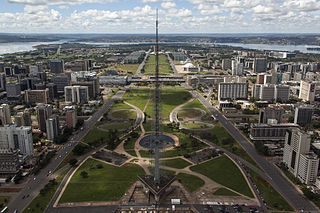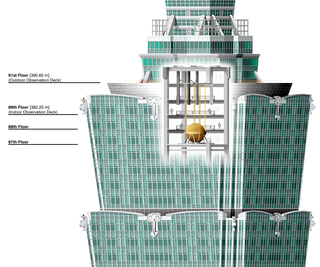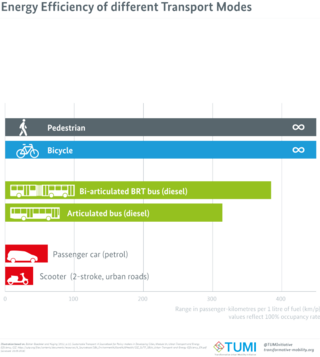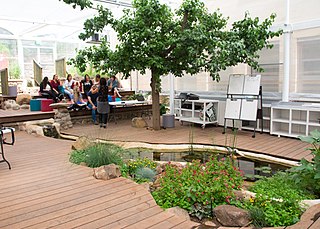Related Research Articles

A disaster is a serious problem occurring over a period of time that causes widespread human, material, economic or environmental loss which exceeds the ability of the affected community or society to cope using its own resources. Disasters are routinely divided into either "natural disasters" caused by natural hazards or "human-instigated disasters" caused from anthropogenic hazards. However, in modern times, the divide between natural, human-made and human-accelerated disasters is difficult to draw.

Urban design is an approach to the design of buildings and the spaces between them that focuses on specific design processes and outcomes. In addition to designing and shaping the physical features of towns, cities, and regional spaces, urban design considers 'bigger picture' issues of economic, social and environmental value and social design. The scope of a project can range from a local street or public space to an entire city and surrounding areas. Urban designers connect the fields of architecture, landscape architecture and urban planning to better organize physical space and community environments.
The biophilia hypothesis suggests that humans possess an innate tendency to seek connections with nature and other forms of life. Edward O. Wilson introduced and popularized the hypothesis in his book, Biophilia (1984). He defines biophilia as "the urge to affiliate with other forms of life".

The term built environment refers to human-made conditions and is often used in architecture, landscape architecture, urban planning, public health, sociology, and anthropology, among others. These curated spaces provide the setting for human activity and were created to fulfill human desires and needs. The term can refer to a plethora of components including the traditionally associated buildings, cities, public infrastructure, transportation, open space, as well as more conceptual components like farmlands, dammed rivers, wildlife management, and even domesticated animals.

Land use planning is the process of regulating the use of land by a central authority. Usually, this is done to promote more desirable social and environmental outcomes as well as a more efficient use of resources. More specifically, the goals of modern land use planning often include environmental conservation, restraint of urban sprawl, minimization of transport costs, prevention of land use conflicts, and a reduction in exposure to pollutants. In the pursuit of these goals, planners assume that regulating the use of land will change the patterns of human behavior, and that these changes are beneficial. The first assumption, that regulating land use changes the patterns of human behavior is widely accepted. However, the second assumption - that these changes are beneficial - is contested, and depends on the location and regulations being discussed.

Closed ecological systems (CES) are ecosystems that do not rely on matter exchange with any part outside the system.
Environmental psychology is a branch of psychology that explores the relationship between humans and the external world. It examines the way in which the natural environment and our built environments shape us as individuals. Environmental psychology emphasizes how humans change the environment and how the environment changes humans' experiences and behaviors. The field defines the term environment broadly, encompassing natural environments, social settings, built environments, learning environments, and informational environments. According to an article on APA Psychnet, environmental psychology is when a person thinks of a plan, travels to a certain place, and follows through with the plan throughout their behavior.

In ecology, resilience is the capacity of an ecosystem to respond to a perturbation or disturbance by resisting damage and recovering quickly. Such perturbations and disturbances can include stochastic events such as fires, flooding, windstorms, insect population explosions, and human activities such as deforestation, fracking of the ground for oil extraction, pesticide sprayed in soil, and the introduction of exotic plant or animal species. Disturbances of sufficient magnitude or duration can profoundly affect an ecosystem and may force an ecosystem to reach a threshold beyond which a different regime of processes and structures predominates. When such thresholds are associated with a critical or bifurcation point, these regime shifts may also be referred to as critical transitions.

Urban resilience has conventionally been defined as the "measurable ability of any urban system, with its inhabitants, to maintain continuity through all shocks and stresses, while positively adapting and transforming towards sustainability".

Sustainable urbanism is both the study of cities and the practices to build them (urbanism), that focuses on promoting their long term viability by reducing consumption, waste and harmful impacts on people and place while enhancing the overall well-being of both people and place. Well-being includes the physical, ecological, economic, social, health and equity factors, among others, that comprise cities and their populations. In the context of contemporary urbanism, the term cities refers to several scales of human settlements from towns to cities, metropolises and mega-city regions that includes their peripheries / suburbs / exurbs. Sustainability is a key component to professional practice in urban planning and urban design along with its related disciplines landscape architecture, architecture, and civil and environmental engineering. Green urbanism and ecological urbanism are other common terms that are similar to sustainable urbanism, however they can be construed as focusing more on the natural environment and ecosystems and less on economic and social aspects. Also related to sustainable urbanism are the practices of land development called Sustainable development, which is the process of physically constructing sustainable buildings, as well as the practices of urban planning called smart growth or growth management, which denote the processes of planning, designing, and building urban settlements that are more sustainable than if they were not planned according to sustainability criteria and principles.

In the fields of engineering and construction, resilience is the ability to absorb or avoid damage without suffering complete failure and is an objective of design, maintenance and restoration for buildings and infrastructure, as well as communities. A more comprehensive definition is that it is the ability to respond, absorb, and adapt to, as well as recover in a disruptive event. A resilient structure/system/community is expected to be able to resist to an extreme event with minimal damages and functionality disruptions during the event; after the event, it should be able to rapidly recovery its functionality similar to or even better than the pre-event level.
Habitat III, the United Nations Conference on Housing and Sustainable Urban Development, took place in Quito, Ecuador, from 17 – 20 October 2016.
Temporary use of empty spaces is a practice in urbanism aiming to revitalize empty spaces in urban areas, especially abandoned and decaying buildings.
Everyday Urbanism is a concept introduced by Margaret Crawford, John Chase and John Kaliski in 1999. Everyday Urbanism is in Margaret Crawford words: ”an approach to Urbanism that finds its meanings in everyday life”. Contrary to New Urbanism, Everyday Urbanism is not concerned with aesthetics but with specific activities of the daily life. It constitutes an empirical approach that strengthens frequently unnoticed existing situations and experiences that occur in everyday life.

Biophilic design is a concept used within the building industry to increase occupant connectivity to the natural environment through the use of direct nature, indirect nature, and space and place conditions. Used at both the building and city-scale, it is argued that this idea has health, environmental, and economic benefits for building occupants and urban environments, with few drawbacks. Although its name was coined in recent history, indicators of biophilic design have been seen in architecture from as far back as the Hanging Gardens of Babylon.
Alessandro Melis is an Italian architect and the curator of the Italian National Pavilion at the 17th Venice Biennale. He is also a professor of architecture and the inaugural endowed chair of the New York Institute of Technology.
Lhouma is a term used in North Africa, to refer to a neighbourhood / quarter characterised by strong social relations between residents and the space in which they live and practice their daily life.

Urban vitality is the quality of those spaces in cities that are capable of attracting heterogeneous people for different types of activities throughout varied time schedules. The areas of the city with high vitality are perceived as alive, lively or vibrant and they tend to attract people to carry out their activities, stroll or stay. However, the areas of low vitality repel people and can be perceived as unsafe.

Perla Serfaty is a French and Canadian academic, sociologist, psychosociologist, writer, and essayist, known in particular for her work on home and intimacy. She is a theorist of domestic intimacy, hospitality and the appropriation of inhabited places, and an expert in environmental psychology. Her book Vieillesse et Engendrements. La longévité dans la tradition juive., dedicated to the traditional Jewish view of longevity as transmitted by the Hebrew Bible, was awarded the J. I. Segal Jewish Book Award in 2014. The contribution of Serfaty's work to environmental psychology was distinguished by her induction in 2018 into the International Association of People-Environment Studies (IAPS) Hall of Fame.
Architectural exaptation is a concept in architecture and urban design that involves repurposing buildings, structures, or architectural elements for new uses that differ significantly from their original intended purpose. This practice extends beyond mere adaptation, as it involves a transformative process where the original functions are replaced or augmented by entirely new ones. It's a concept that embraces flexibility, creativity, and innovation in the use of architectural spaces and structures.
References
- ↑ Lara-Hernandez, J. Antonio; Melis, Alessandro (May 2018). "Understanding the temporary appropriation in relationship to social sustainability". Sustainable Cities and Society. 39: 366–374. doi:10.1016/j.scs.2018.03.004.
- ↑ Graumann, Carl Friedrich (1976). "The Concept of Appropriation (Aneignung)And Modes of Appropriation of Space". Appropriation of Space. 6 (2).
- ↑ Trollope-Kumar, Karen, Last, John M., "Encyclopedia of Public Health: Cultural Factors", 2002
- ↑ Bonfil Batalla, Guillermo (1991). Pensar nuestra cultura : ensayos (PDF) (1 ed.). México, D.F.: Alianza Editorial. ISBN 968-39-0481-5.
- ↑ "Built Environment | Definition of Built Environment by Oxford Dictionary on Lexico.com also meaning of Built Environment". Lexico Dictionaries | English. Archived from the original on October 29, 2020. Retrieved 24 August 2020.
- ↑ Korosec-Serfaty, Paola (1976). Appropriation of Space: Proceedings of the Strasbourg Conference (1 ed.). Strasbourg: Louis Pasteur University. p. 655.
- ↑ Graumann, Carl Friedrich (1976). "The Concept of Appropriation (Aneignung)And Modes of Appropriation of Space". Appropriation of Space. 6 (2).
- ↑ Purcell, Mark (2002). "Excavating Lefebvre: The right to the city and its urban politics of the inhabitant". GeoJournal. 58 (2/3): 99–108. doi:10.1023/B:GEJO.0000010829.62237.8f. S2CID 18096395.
- ↑ Pol, Enric (2002). Psicología y medio ambiente. Aspectos psicosociales, educativos y metodológicos. A Coruña: Asociación Galega de Estudios e Investigacion Psicosocial-Publiedisa. pp. 123–132.
- ↑ Yory, Carlos Mario (2011). "El Concepto de Topofilia entendido como Teoría del Lugar" (PDF). Revista Barrio Taller: 1–17.
- ↑ Lara-Hernandez, Jose Antonio (2023-01-01), Allam, Zaheer; Chabaud, Didier; Gall, Catherine; Pratlong, Florent (eds.), "Chapter 29 - Building urban resilience through infrastructure exaptation", Resilient and Sustainable Cities, Elsevier, pp. 537–549, ISBN 978-0-323-91718-6 , retrieved 2023-08-23
- ↑ Lara-Hernandez, Jose Antonio (2023-12-01). "Emergent temporary appropriation versus lockdown regulations: The case of Venice". Sustainable Cities and Society. 99: 104854. doi:10.1016/j.scs.2023.104854. ISSN 2210-6707. S2CID 260879763.
- ↑ Lara-Hernandez, Jose Antonio (2019). Temporary appropriation : theory and practice of the street. Portsmouth, UK: University of Portsmouth.